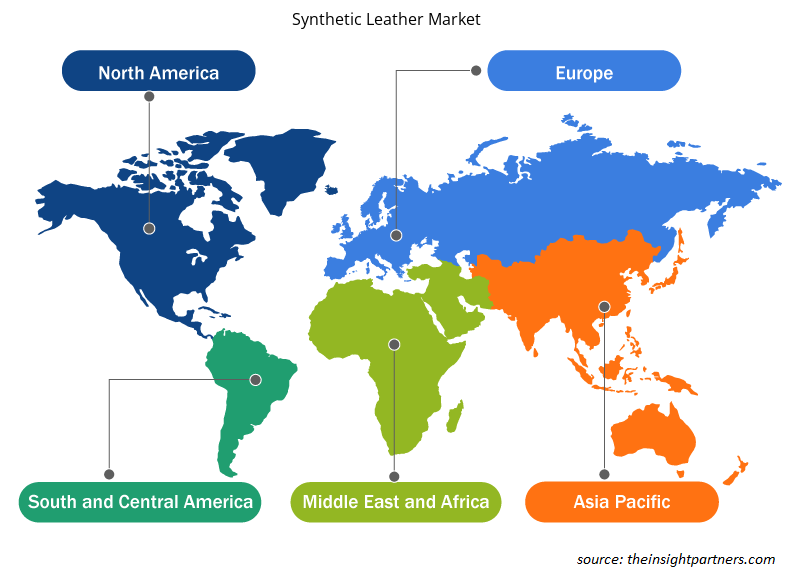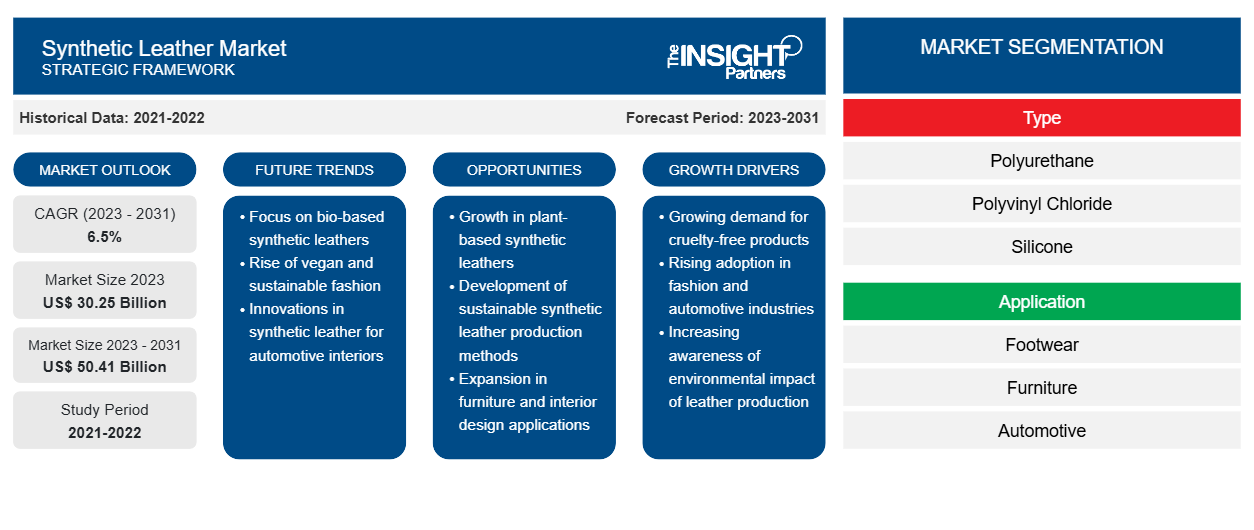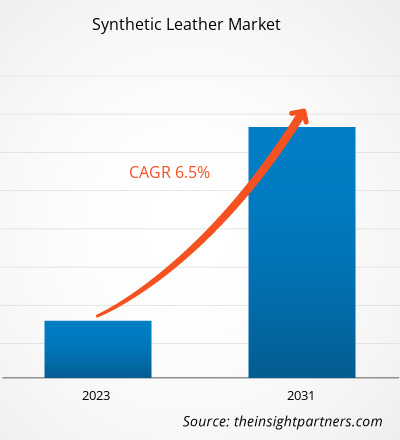合成皮革市場規模は、2023年の302.5億米ドルから2031年には504.1億米ドルに達すると予測されています。市場は2023年から2031年にかけて6.5%のCAGRを記録すると予想されています。バイオベースレザーの開発への注目の高まりは、合成皮革市場の重要なトレンドであり続けると思われます。
合成皮革市場分析
合成皮革はここ数年人気が高まっています。靴、衣類、家具、自動車など、さまざまな業界で使用されています。合成皮革の最も一般的な用途は、衣類、荷物、ケースです。合成皮革は、ジャケット、コート、ハンドバッグ、財布、ベルトなどにますます使用されています。合成皮革は、低コストで耐摩耗性があるため、靴に適しています。
合成皮革市場の概要
合成皮革は、ポリ塩化ビニル、ポリウレタン、着色顔料、裏地などの原材料を押し出して製造されます。家具、履物、自動車などの業界からの需要の増加により、合成皮革の需要が促進されると予想されます。さらに、大手企業による投資の増加により、市場の成長が促進されると予想されます。
要件に合わせてレポートをカスタマイズする
このレポートの一部、国レベルの分析、Excelデータパックなど、あらゆるレポートを無料でカスタマイズできます。また、スタートアップや大学向けのお得なオファーや割引もご利用いただけます。
- このレポートの主要な市場動向を入手してください。この無料サンプルには、市場動向から見積もりや予測に至るまでのデータ分析が含まれます。
合成皮革市場の推進要因と機会
合成皮革の利点
合成皮革には、いくつかの利点があります。変更や改良を加えると、本物の革のような質感で見た目が再現されます。合成皮革は、さまざまな色、仕上げ、パターンで利用できる多用途の素材です。合成皮革のコストは本革に比べて低いため、はるかに手頃な選択肢となります。さらに、合成皮革は防水素材で、プラスチック コーティングを施したプラスチック ベース層で構成されているため、水の浸入を防ぐことができます。その結果、合成皮革は、湿気や湿度に継続的にさらされる用途に最適です。このように、合成皮革の使用に関連する利点が市場を牽引しています。
靴業界からの需要増加
履物業界は、合成皮革業界の重要なセグメントの 1 つです。靴の需要が高いため、履物業界は発展し、成長する機会を得ています。合成皮革素材は、低コストで耐摩耗性に優れているため、靴に適しています。また、合成皮革の靴は防水性に優れています。合成皮革にいくつかの化学物質を混ぜて防水機能を追加することができます。履物業界からの合成皮革の需要は高く、さらに、多くの履物ブランドが植物由来の革靴やビーガンレザーの靴の開発に注力しています。これが合成皮革の需要の高まりにさらに貢献しています。このように、履物業界からの需要の高まりは、合成皮革市場にチャンスを生み出しています。
合成皮革市場レポートのセグメンテーション分析
合成皮革市場分析の導出に貢献した主要なセグメントは、基油、製品タイプ、および最終用途産業です。
- 合成皮革市場は、タイプ別にポリウレタン、ポリ塩化ビニル、シリコーン、その他に分類されます。ポリウレタンセグメントは2023年に大きな市場シェアを占めました。
- 用途別に見ると、市場は履物、家具、自動車、衣料、文房具、その他に分類されます。 2023年には履物セグメントが市場で最大のシェアを占めました。
合成皮革市場シェアの地域別分析
合成皮革市場レポートの地理的範囲は、主に北米、ヨーロッパ、アジア太平洋、ヨーロッパ、中東およびアフリカ、南米/中南米の 5 つの地域に分かれています。
アジア太平洋地域は合成皮革市場を支配してきました。アジア太平洋地域の履物市場は、中国、インドネシア、インドなどの国々における急速な都市化、人口増加、工業化によって推進されています。また、AmazonやAlibabaなどの電子商取引プラットフォームの普及により、消費者は履物を便利に購入できるようになりました。その結果、履物業界、ファッション、室内装飾業界からの需要が高まり、靴やジャケット、荷物や財布、車の内装、特にシート、電子機器ケース、ソファなど、さまざまなアイテムが対象となっています。アジア太平洋地域は、今後最も急速に成長する地域になると予想されています。
合成皮革市場の地域別分析
予測期間を通じて合成皮革市場に影響を与える地域的な傾向と要因は、Insight Partners のアナリストによって徹底的に説明されています。このセクションでは、北米、ヨーロッパ、アジア太平洋、中東、アフリカ、南米、中米にわたる合成皮革市場のセグメントと地理についても説明します。

- 合成皮革市場の地域別データを入手
合成皮革市場レポートの範囲
| レポート属性 | 詳細 |
|---|---|
| 2023年の市場規模 | 302.5億米ドル |
| 2031年までの市場規模 | 504.1億米ドル |
| 世界のCAGR(2023年~2031年) | 6.5% |
| 履歴データ | 2021-2022 |
| 予測期間 | 2023-2031 |
| 対象セグメント | タイプ別
|
| 対象地域と国 | 北米
|
| 市場リーダーと主要企業プロフィール |
|
合成皮革市場のプレーヤーの密度:ビジネスダイナミクスへの影響を理解する
合成皮革市場は、消費者の嗜好の変化、技術の進歩、製品の利点に対する認識の高まりなどの要因により、エンドユーザーの需要が高まり、急速に成長しています。需要が高まるにつれて、企業は提供を拡大し、消費者のニーズを満たすために革新し、新たなトレンドを活用し、市場の成長をさらに促進しています。
市場プレーヤー密度とは、特定の市場または業界内で活動している企業または会社の分布を指します。これは、特定の市場スペースに、その市場規模または総市場価値に対してどれだけの競合相手 (市場プレーヤー) が存在するかを示します。
合成皮革市場で事業を展開している主要企業は次のとおりです。
- 株式会社クラレ
- 三芳化学工業株式会社
- 帝人株式会社
- 南亜プラスチック株式会社
- 株式会社フィルウェル
- アルファテックスイタリア
免責事項:上記の企業は、特定の順序でランク付けされていません。

- 合成皮革市場のトップキープレーヤーの概要を入手
合成皮革市場のニュースと最近の動向
合成皮革市場は、重要な企業出版物、協会データ、データベースを含む一次調査と二次調査後の定性的および定量的データを収集することによって評価されます。以下は、市場の動向の一覧です。
- 50 年の経験を持つシリコーン製品の専門メーカーであるゼネラルシリコーン (GS) は、新しい Compo-SiL® SL シリコーン ヴィーガンレザー製品シリーズの発売を発表しました。SL シリーズは、工場で布地の裏地を施したヴィーガンレザー製品を探しているバッグやバックパック、靴、財布、ベルト、本の装丁、カバーなどの消費者向け製品のメーカーに適しています。(出典: ゼネラルシリコーン株式会社、会社ニュース、2023 年)
合成皮革市場レポートの対象範囲と成果物
「合成皮革市場の規模と予測(2021〜2031年)」レポートでは、以下の分野をカバーする市場の詳細な分析を提供しています。
- 対象範囲に含まれるすべての主要市場セグメントの世界、地域、国レベルでの市場規模と予測
- 市場の動向(推進要因、制約、主要な機会など)
- 今後の主な動向
- ポーターの5つの力とSWOT分析の詳細
- 主要な市場動向、主要プレーヤー、規制、最近の市場動向を網羅した世界および地域の市場分析
- 市場集中、ヒートマップ分析、主要プレーヤー、最近の動向を網羅した業界の状況と競争分析
- 詳細な企業プロフィール
- 過去2年間の分析、基準年、CAGRによる予測(7年間)
- PEST分析とSWOT分析
- 市場規模価値/数量 - 世界、地域、国
- 業界と競争環境
- Excel データセット



Report Coverage
Revenue forecast, Company Analysis, Industry landscape, Growth factors, and Trends

Segment Covered
This text is related
to segments covered.

Regional Scope
North America, Europe, Asia Pacific, Middle East & Africa, South & Central America

Country Scope
This text is related
to country scope.
Trends and growth analysis reports related to Chemicals and Materials : READ MORE..
The Insight Partners performs research in 4 major stages: Data Collection & Secondary Research, Primary Research, Data Analysis and Data Triangulation & Final Review.
- Data Collection and Secondary Research:
As a market research and consulting firm operating from a decade, we have published and advised several client across the globe. First step for any study will start with an assessment of currently available data and insights from existing reports. Further, historical and current market information is collected from Investor Presentations, Annual Reports, SEC Filings, etc., and other information related to company’s performance and market positioning are gathered from Paid Databases (Factiva, Hoovers, and Reuters) and various other publications available in public domain.
Several associations trade associates, technical forums, institutes, societies and organization are accessed to gain technical as well as market related insights through their publications such as research papers, blogs and press releases related to the studies are referred to get cues about the market. Further, white papers, journals, magazines, and other news articles published in last 3 years are scrutinized and analyzed to understand the current market trends.
- Primary Research:
The primarily interview analysis comprise of data obtained from industry participants interview and answers to survey questions gathered by in-house primary team.
For primary research, interviews are conducted with industry experts/CEOs/Marketing Managers/VPs/Subject Matter Experts from both demand and supply side to get a 360-degree view of the market. The primary team conducts several interviews based on the complexity of the markets to understand the various market trends and dynamics which makes research more credible and precise.
A typical research interview fulfils the following functions:
- Provides first-hand information on the market size, market trends, growth trends, competitive landscape, and outlook
- Validates and strengthens in-house secondary research findings
- Develops the analysis team’s expertise and market understanding
Primary research involves email interactions and telephone interviews for each market, category, segment, and sub-segment across geographies. The participants who typically take part in such a process include, but are not limited to:
- Industry participants: VPs, business development managers, market intelligence managers and national sales managers
- Outside experts: Valuation experts, research analysts and key opinion leaders specializing in the electronics and semiconductor industry.
Below is the breakup of our primary respondents by company, designation, and region:

Once we receive the confirmation from primary research sources or primary respondents, we finalize the base year market estimation and forecast the data as per the macroeconomic and microeconomic factors assessed during data collection.
- Data Analysis:
Once data is validated through both secondary as well as primary respondents, we finalize the market estimations by hypothesis formulation and factor analysis at regional and country level.
- Macro-Economic Factor Analysis:
We analyse macroeconomic indicators such the gross domestic product (GDP), increase in the demand for goods and services across industries, technological advancement, regional economic growth, governmental policies, the influence of COVID-19, PEST analysis, and other aspects. This analysis aids in setting benchmarks for various nations/regions and approximating market splits. Additionally, the general trend of the aforementioned components aid in determining the market's development possibilities.
- Country Level Data:
Various factors that are especially aligned to the country are taken into account to determine the market size for a certain area and country, including the presence of vendors, such as headquarters and offices, the country's GDP, demand patterns, and industry growth. To comprehend the market dynamics for the nation, a number of growth variables, inhibitors, application areas, and current market trends are researched. The aforementioned elements aid in determining the country's overall market's growth potential.
- Company Profile:
The “Table of Contents” is formulated by listing and analyzing more than 25 - 30 companies operating in the market ecosystem across geographies. However, we profile only 10 companies as a standard practice in our syndicate reports. These 10 companies comprise leading, emerging, and regional players. Nonetheless, our analysis is not restricted to the 10 listed companies, we also analyze other companies present in the market to develop a holistic view and understand the prevailing trends. The “Company Profiles” section in the report covers key facts, business description, products & services, financial information, SWOT analysis, and key developments. The financial information presented is extracted from the annual reports and official documents of the publicly listed companies. Upon collecting the information for the sections of respective companies, we verify them via various primary sources and then compile the data in respective company profiles. The company level information helps us in deriving the base number as well as in forecasting the market size.
- Developing Base Number:
Aggregation of sales statistics (2020-2022) and macro-economic factor, and other secondary and primary research insights are utilized to arrive at base number and related market shares for 2022. The data gaps are identified in this step and relevant market data is analyzed, collected from paid primary interviews or databases. On finalizing the base year market size, forecasts are developed on the basis of macro-economic, industry and market growth factors and company level analysis.
- Data Triangulation and Final Review:
The market findings and base year market size calculations are validated from supply as well as demand side. Demand side validations are based on macro-economic factor analysis and benchmarks for respective regions and countries. In case of supply side validations, revenues of major companies are estimated (in case not available) based on industry benchmark, approximate number of employees, product portfolio, and primary interviews revenues are gathered. Further revenue from target product/service segment is assessed to avoid overshooting of market statistics. In case of heavy deviations between supply and demand side values, all thes steps are repeated to achieve synchronization.
We follow an iterative model, wherein we share our research findings with Subject Matter Experts (SME’s) and Key Opinion Leaders (KOLs) until consensus view of the market is not formulated – this model negates any drastic deviation in the opinions of experts. Only validated and universally acceptable research findings are quoted in our reports.
We have important check points that we use to validate our research findings – which we call – data triangulation, where we validate the information, we generate from secondary sources with primary interviews and then we re-validate with our internal data bases and Subject matter experts. This comprehensive model enables us to deliver high quality, reliable data in shortest possible time.


 このレポートの無料サンプルを入手する
このレポートの無料サンプルを入手する